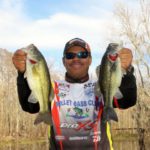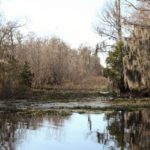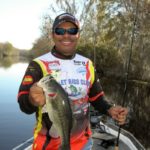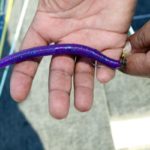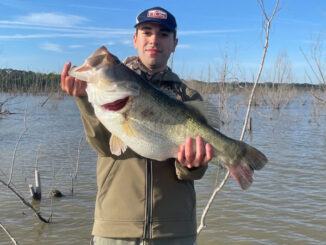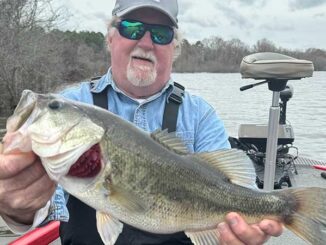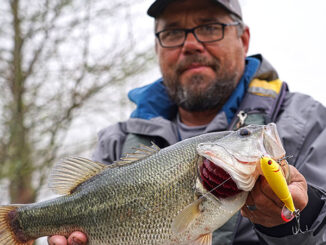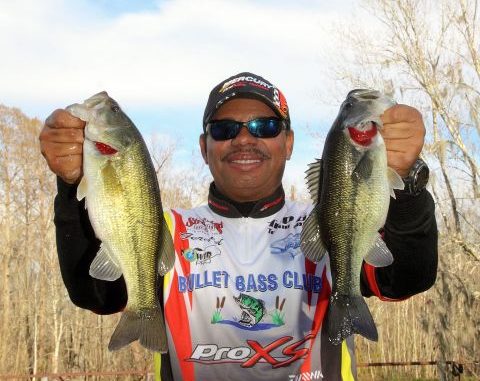
Cold water temperatures can definitely make bass fishing more difficult, but the Blue Bird Canal south of Houma is filled with fish. Here’s one coastal angler’s suggestions on boating a few.
Drive or ride in any bass boat above the Tropic of Cancer late in December, particularly in coastal Louisiana’s semi-tropical region, and there still is a reasonable chance you’ll feel like you’ve gotten frost bite when attempting to catch a bass.
Riding with Patterson local Gerald Foulcard at an exceedingly high rate of speed along the Intracoastal Waterway, I was certain only the prop of his boat was still in the water. I wondered if my bass-chasing friend was actually taking me fishing or trying to demonstrate he could match Santa Claus when it came to speed, distance and time.
Foulcard works for Central Louisiana Electrical Co-op and spends a lot of time 20 feet overhead in a bucket truck. Being a tournament bass angler and member of Bullet Bass Club, he doesn’t have much time to make too many relaxed excursions. He enjoys competing more than relaxing.
So you wouldn’t know our trip was supposed to be laid-back from how fast we traveled to our location south of Bayou Black Marina near Houma. Desitnation: the Bluebird Canal.
My body’s inner core was about to go into convulsive shivers. And the rush of air beneath my glasses caused my eyes to water up, blurring them so badly I didn’t have a clue where we were at first.
But this early Christmas present in the form of a winter bass trip was something we’d talked about doing since the summer, when I ran into Foulcard and his wife Angie on the cereal isle in Wal-Mart.
Foulcard set the troll motor down and made several casts with a rod he already had rigged, while I fumbled around with numb fingertips trying to rig up a jig so I could punch into some vegetation killed by frost. I was used to cold from the struggles of waterfowl hunting, where wrestling strings of decoys, push-poling pirogues and the excitement of rushing wings keep you warm for some reason.
The thing I learned from Foulcard during our Cajun Christmas expedition was at this time of year bass feel the same way I did — cold. What’s more, it takes a certain skill set to get them to bite consistently.
And Foulcard is someone who possesses this particular set of skills.
The Bluebird Canal is surrounded by marsh. And this particular region is a place where my bass-angling partner had won his share of tournaments over the years — spring, summer, fall and winter.
Foulcard said he had a couple of favorite tactics during when the weather turns cold.
“Basically, when the water temperature is a cold 49 degrees in the marsh, what I normally use — most of the time — is a single-blade spinnerbait that can dive a little deeper and can be fished a little slower,” he explained. “My second bait of choice for winter fishing is an 8-inch lizard.
“But, you have to let the fish tell you what it wants. It’s trial and error. You have to feel them out.”
“Feel,” I thought to myself. I couldn’t feel my fingers, so how was I supposed to feel a fish?
Nonetheless, when I got my first bite it occurred to me that my fingers had nothing to do with the winter tactics Foulard suggested.
“With these two baits I’m trying to establish a pattern to determine if they want a slow-moving spinnerbait or possibly even a crankbait,” Foulcard said. “The plastic lizard is the kind of bait that will aggravate them, particularly as we get closer to spawning time, because Louisiana’s winter bass are looking for a place to spawn.
“And though they haven’t committed yet, they’re scoping out a spot. When a lizard gets in the way, that’s a no-no — they want that out of the way.”
Biologically a bass gets more active the warmer the water gets, becoming more and more aggressive the closer to and during the spawn in late February, March and April. After the spawn, bass are hungry and want to eat. During the summer dog days, bass slow down and are active during the early morning and last light of evening.
The winter doesn’t fit any of these more-aggressive periods, so it is a time when presentation is important.
“In the winter, my experience is you have to have a slower presentation, especially when the water is cold — like 49 degrees,”
he said. “I look at humans. Humans are pretty lethargic in the wintertime because it’s cold. It’s not comfortable — you’re outside your comfort zone.
“But, if you’re inside or the temperature warms up, you’re more apt to want to do things and move around a little bit more and be more active. I sort of relate bass behavior to human behavior.”
According to Foulcard, although you might not catch as many fish during the winter, it can be more rewarding than other times of the year. The angler said that, unlike spring and summer when you catch a lot more fish, during the winter what you catch is usually bigger.
The angler also said high pressure, bluebird days common as cold fronts push through the area seem to push fish deeper.
But when the barometric pressure falls between these fronts, bass definitely become more active.
“I guess it’s easier on their bodies,” Foulcard said. “On cloudy days they seem to move around a lot more. They’re more comfortable on low-pressure days. When you’re comfortable you tend to want to do more things; you feel better.”
Another wintertime bait Foulcard suggested is the crankbait — but he said one that has a little more wobble will be more effective. Slower crankbaits provide a slower presentation and give bass something to look at for longer periods of time.
Crankbaits like Kevin VanDam-series wide-billed models provide increased wobble and more vibration.
“The thinner the bill, the tighter the wobble; the wider the bill, the wider the wobble,” Foulcard said. “Wider bills like KVDs tend to work better in high-pressure situations during winter months.”
Colors also matter this month, said Foulcard, who sticks with white and chartreuse in clear water and often goes with solid black when it’s cloudy.
The angler also pointed out that Colorado blades provide more vibration than willow-leaf blades. Beefing up the blades makes a big difference during the winter, when it is a reaction bite Foulcard is soliciting more than a strike from a hungry fish.
“You want to get that fish’s attention,” Foulcard said. “It may not want to feed. But, because he feels it, it may become a reaction bite. And, because he’s not hungry and sees it, it’s aggravating to him, and he bites it.
“He’s not so much trying to eat it.”
When winter fishing for bass, Foulcard never passes up a pipeline or intersection of two ends of a pipeline in a main canal.
“You have what I call magnets. You have trees. You have grass. And you have water flow,” he said. “If you have all of those elements you’ll have baitfish around pipelines. You’ll also have crawfish.
“So bass will use these areas because it’s easier to get meat when they are sluggish. That’s especially true in the winter because, keep in mind, crawfish season is right around the corner. Crawfish are coming out of the pipeline with the baitfish. But you have other predator fish like perch that bass will also eat. All of these are what I call magnets because bass will hover around these areas to get a meal.”
At midday, Foulcard pointed his boat west, and we headed for the landing. Our close proximity to the tropic’s northern zenith took away some of the winter chill I had experienced that morning.
But I was still anxious to recline in my easy chair by the fireplace when I got home, where I could replay Foulcard’s early Christmas present.
